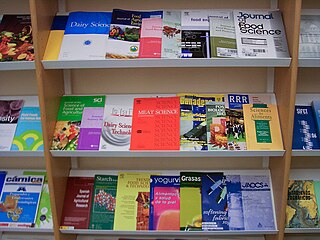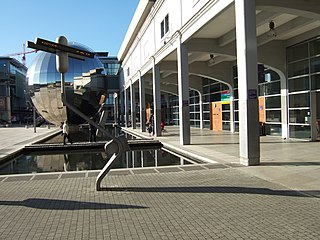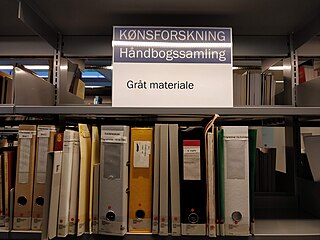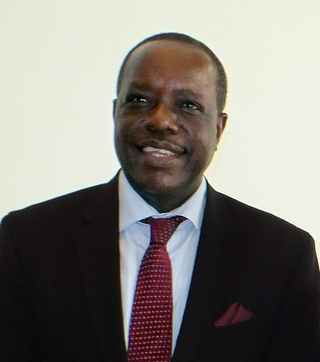Related Research Articles

Metrology is the scientific study of measurement. It establishes a common understanding of units, crucial in linking human activities. Modern metrology has its roots in the French Revolution's political motivation to standardise units in France when a length standard taken from a natural source was proposed. This led to the creation of the decimal-based metric system in 1795, establishing a set of standards for other types of measurements. Several other countries adopted the metric system between 1795 and 1875; to ensure conformity between the countries, the Bureau International des Poids et Mesures (BIPM) was established by the Metre Convention. This has evolved into the International System of Units (SI) as a result of a resolution at the 11th General Conference on Weights and Measures (CGPM) in 1960.

An academic journal or scholarly journal is a periodical publication in which scholarship relating to a particular academic discipline is published. They serve as permanent and transparent forums for the presentation, scrutiny, and discussion of research. They nearly universally require peer review for research articles or other scrutiny from contemporaries competent and established in their respective fields.

Elsevier is a Dutch academic publishing company specializing in scientific, technical, and medical content. Its products include journals such as The Lancet, Cell, the ScienceDirect collection of electronic journals, Trends, the Current Opinion series, the online citation database Scopus, the SciVal tool for measuring research performance, the ClinicalKey search engine for clinicians, and the ClinicalPath evidence-based cancer care service. Elsevier's products and services include digital tools for data management, instruction, research analytics, and assessment. Elsevier is part of the RELX Group, known until 2015 as Reed Elsevier, a publicly-traded company. According to RELX reports, in 2022 Elsevier published more than 600,000 articles annually in over 2,800 journals; as of 2018 its archives contained over 17 million documents and 40,000 e-books, with over one billion annual downloads.

We The Curious is a science and arts centre and educational charity in Bristol, England. It features over 250 interactive exhibits over two floors, and members of the public and school groups can also engage with the Live Science Team over programming in the kitchen, studio and on live lab. We The Curious is also home of the United Kingdom's first 3D planetarium. The centre describes its aim as being "to create a culture of curiosity".

Grey literature is materials and research produced by organizations outside of the traditional commercial or academic publishing and distribution channels. Common grey literature publication types include reports, working papers, government documents, white papers and evaluations. Organizations that produce grey literature include government departments and agencies, civil society or non-governmental organizations, academic centres and departments, and private companies and consultants.
Cambridge Scientific Abstracts was a division of Cambridge Information Group and provider of online databases, based in Bethesda, Maryland, before merging with ProQuest of Ann Arbor, Michigan, in 2007. CSA hosted databases of abstracts and developed taxonomic indexing of scholarly articles. These databases were hosted on the CSA Illumina platform and were available alongside add-on products like CSA Illustrata. The company produced numerous bibliographic databases in different fields of the arts and humanities, natural and social sciences, and technology. Thus, coverage included materials science, environmental sciences and pollution management, biological sciences, aquatic sciences and fisheries, biotechnology, engineering, computer science, sociology, linguistics, and other areas.
Emmanuel Babatunde Alo is a Nigerian professor of applied biology, ecosystems, entomology and parasitology.

Lawrence N. Shaw was an American physicist, curator, and artist. Shaw worked at the Exploratorium, a San Francisco science museum, for 33 years, performing just about every function for the museum. He was a key member of the arts and technology community in the San Francisco Bay Area.
The Exploradôme is a science museum located in Vitry-sur-Seine in the Val-de-Marne, France. It was founded by Goéry Delacôte. It is open daily; an admission fee is charged.
PASCAL is a scientific bibliographic database, which is maintained by INIST (CNRS). PASCAL covers the core scientific literature in science, technology and medicine with a special emphasis on European literature.

Carnets Geol. is an electronic journal that publishes in the field of geosciences, and particularly paleontology, stratigraphy, and sedimentology. The open-access journal is one of the founding members of the OA portal GeoSciences e-Journals. Since 2007, it is published by the eponymic Association Carnets de Géologie at the University of Western Brittany in Brest, France.

The Exploratorium is a museum of science, technology, and arts in San Francisco, California. Founded by physicist and educator Frank Oppenheimer in 1969, the museum was originally located in the Palace of Fine Arts and was relocated in 2013 to Piers 15 and 17 on San Francisco's waterfront.
The Grey Literature International Steering Committee (GLISC) was established in 2006 after the 7th International Conference on Grey Literature (GL7) held in Nancy (France) on 5–6 December 2005.
The “European Association for Grey Literature Exploitation” (EAGLE) was created in 1985 by European scientific and technical information centres and libraries in order to produce the bibliographic database “System for Information on Grey Literature in Europe” (SIGLE).
DOGE is an academic bibliographic database, which is maintained by INIST, French National Centre for Scientific Research (CNRS), in collaboration with the "Réseau d’Information en Gestion des Entreprises" – under the coordination of the Institut Européen de Données Financières, EUROFIDAI, and the CNRS Department of Humanities and Social Sciences (SHS). DOGE covers research documents in all aspects of business management with special emphasis on European literature.

DataCite is an international not-for-profit organization which aims to improve data citation in order to:

Sospeter Mwijarubi Muhongo MP is a Tanzanian geologist and a nominated member of the Tanzanian Parliament.

The Chief Scientist of the Air Force is the most senior science and technology representative in the United States Department of the Air Force. The current Chief Scientist of the United States Air Force is Victoria Coleman, sworn in on April 6, 2021.
Goéry Delacôte, Légion d'honneur, is a French theoretical physicist and science educator. He has been involved with the direction of science centres in Europe and the United States. He was instrumental in establishing the Cité des Sciences et de l'Industrie in Paris, and was head of scientific information and communication at the Centre National de la Recherche Scientifique (CNRS) for 10 years from 1982.

The history of scuba diving is closely linked with the history of the equipment. By the turn of the twentieth century, two basic architectures for underwater breathing apparatus had been pioneered; open-circuit surface supplied equipment where the diver's exhaled gas is vented directly into the water, and closed-circuit breathing apparatus where the diver's carbon dioxide is filtered from the exhaled breathing gas, which is then recirculated, and more gas added to replenish the oxygen content. Closed circuit equipment was more easily adapted to scuba in the absence of reliable, portable, and economical high pressure gas storage vessels. By the mid-twentieth century, high pressure cylinders were available and two systems for scuba had emerged: open-circuit scuba where the diver's exhaled breath is vented directly into the water, and closed-circuit scuba where the carbon dioxide is removed from the diver's exhaled breath which has oxygen added and is recirculated. Oxygen rebreathers are severely depth limited due to oxygen toxicity risk, which increases with depth, and the available systems for mixed gas rebreathers were fairly bulky and designed for use with diving helmets. The first commercially practical scuba rebreather was designed and built by the diving engineer Henry Fleuss in 1878, while working for Siebe Gorman in London. His self contained breathing apparatus consisted of a rubber mask connected to a breathing bag, with an estimated 50–60% oxygen supplied from a copper tank and carbon dioxide scrubbed by passing it through a bundle of rope yarn soaked in a solution of caustic potash. During the 1930s and all through World War II, the British, Italians and Germans developed and extensively used oxygen rebreathers to equip the first frogmen. In the U.S. Major Christian J. Lambertsen invented a free-swimming oxygen rebreather. In 1952 he patented a modification of his apparatus, this time named SCUBA, an acronym for "self-contained underwater breathing apparatus," which became the generic English word for autonomous breathing equipment for diving, and later for the activity using the equipment. After World War II, military frogmen continued to use rebreathers since they do not make bubbles which would give away the presence of the divers. The high percentage of oxygen used by these early rebreather systems limited the depth at which they could be used due to the risk of convulsions caused by acute oxygen toxicity.
References
- ↑ "Goéry Delacôte: Executive Profile & Biography". Bloomberg Businessweek . Archived from the original on 13 October 2017. Retrieved 6 June 2012.
- ↑ Bronwyn, L. "Goery Delacote, directeur de l'Exploratorium de San Francisco". europusa.com. Archived from the original on 22 December 2011. Retrieved 6 June 2012.